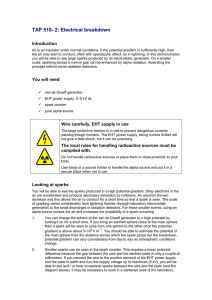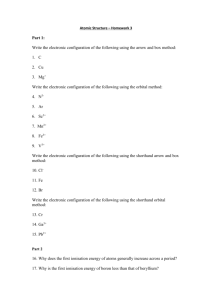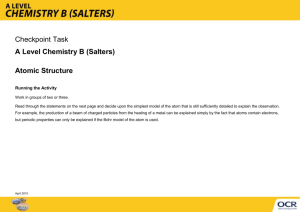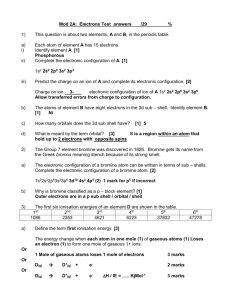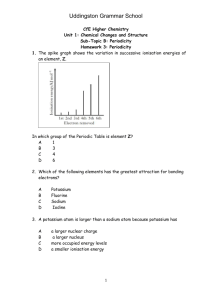TAP 509- 4: Rays make ions - Teaching Advanced Physics
advertisement
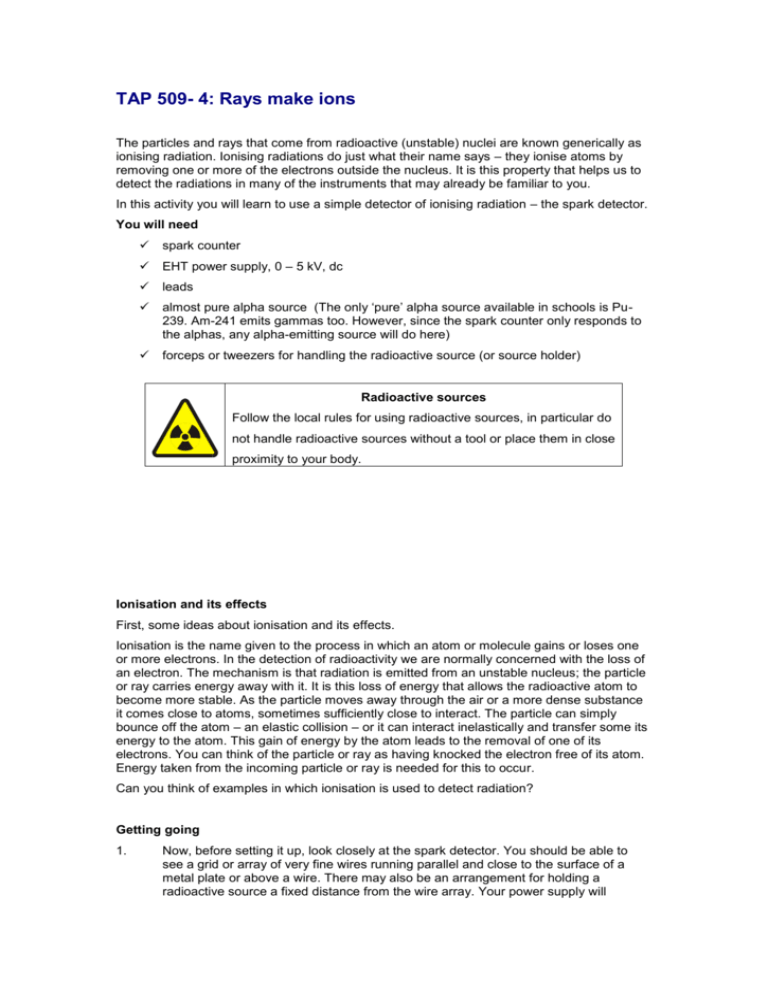
TAP 509- 4: Rays make ions The particles and rays that come from radioactive (unstable) nuclei are known generically as ionising radiation. Ionising radiations do just what their name says – they ionise atoms by removing one or more of the electrons outside the nucleus. It is this property that helps us to detect the radiations in many of the instruments that may already be familiar to you. In this activity you will learn to use a simple detector of ionising radiation – the spark detector. You will need spark counter EHT power supply, 0 – 5 kV, dc leads almost pure alpha source (The only ‘pure’ alpha source available in schools is Pu239. Am-241 emits gammas too. However, since the spark counter only responds to the alphas, any alpha-emitting source will do here) forceps or tweezers for handling the radioactive source (or source holder) Radioactive sources Follow the local rules for using radioactive sources, in particular do not handle radioactive sources without a tool or place them in close proximity to your body. Ionisation and its effects First, some ideas about ionisation and its effects. Ionisation is the name given to the process in which an atom or molecule gains or loses one or more electrons. In the detection of radioactivity we are normally concerned with the loss of an electron. The mechanism is that radiation is emitted from an unstable nucleus; the particle or ray carries energy away with it. It is this loss of energy that allows the radioactive atom to become more stable. As the particle moves away through the air or a more dense substance it comes close to atoms, sometimes sufficiently close to interact. The particle can simply bounce off the atom – an elastic collision – or it can interact inelastically and transfer some its energy to the atom. This gain of energy by the atom leads to the removal of one of its electrons. You can think of the particle or ray as having knocked the electron free of its atom. Energy taken from the incoming particle or ray is needed for this to occur. Can you think of examples in which ionisation is used to detect radiation? Getting going 1. Now, before setting it up, look closely at the spark detector. You should be able to see a grid or array of very fine wires running parallel and close to the surface of a metal plate or above a wire. There may also be an arrangement for holding a radioactive source a fixed distance from the wire array. Your power supply will maintain a high potential difference between the plate and the wires. There will be a large electric field in the space between the wires and the plate. Wire carefully, EHT supply I use Although school EHT supplies are currentlimited and safe, using the extra limiting resister (50 MΩ) reduces the shock current to a trivial level. 2. Now connect up the detector to the power supply. Ask for help if you are not certain how to do this. To be safe the wires (the part you are most likely to touch) should be at earth (0 V) potential. Adjust the EHT until sparks just pass, then reduce it slightly. 3. Insert a source of alpha particles into the holder and ensure that the source is pointing towards the wire array and about 10 mm from it. Take the usual handling precautions with the source. – 0V e.h.t. + + 5 kV 5 kV 0V 4. Does an increase in the potential difference make a significant change in the sparking rate? The alpha particles ionise the air molecules as they travel from the source. The sparking is a result of what happens when the ionisation occurs in the strong electric field produced by the spark detector. Look at the diagram. The field is directed between the wire and the gauze, or between the wires and the plate. So, once the electron and its ion (the original atom) are separated, the electron moves towards the wire and the ion moves towards the plate. The ion has a large mass and so gains speed slowly. The electron, however, has a low mass so its acceleration is large. (You might want to estimate how large it is: to do this use the distance from wire to plate and the voltage setting to make a reasonable estimate of the electric field strength, hence the force and the acceleration.) If an electron can gain enough energy from the field it will be able to collide with another gas atom and cause a further ionisation. So one electron has now produced two: the original one plus the one from this second ionisation. Both of these can go on to accelerate and ionise again. The number of electrons in the space builds up rapidly and eventually the air contains enough electrons in one region to allow a spark to jump from wire to plate. This is known as a cascade process. You have seen that 1. Radioactive particles are often detected using ionisation. Examples include the spark detector, the Geiger–Müller tube, the cloud and bubble chambers, and photographic detection methods. 2. Such methods show us where the particles have caused ionisation. They are not direct detections of the particles themselves. 3. Some methods rely on a cascade process in which ions are multiplied by successive ionisations in a strong electric field. Also try TAP 519: Particle Detectors Practical advice Students may need close supervision in using this apparatus. They will also need guidance in the correct earth setting to avoid electric shock. The instructions provided in the activity may need to be altered to suit the style of spark detector you have. Radioactive sources Follow the local rules for using radioactive sources, in particular do not handle radioactive sources without a tool or place them in close proximity to your body. Wire carefully, EHT supply in use Social and human context Every time your teeth are x-rayed, ionisation processes are used to expose the film. The ubiquitous Geiger–Müller tube involves a controlled cascade between the central wire and the outer cylinder inside the tube. We rely heavily on the ionising effects of radiation for its detection. External reference This activity is taken from Advancing Physics chapter 18 activity 50E
